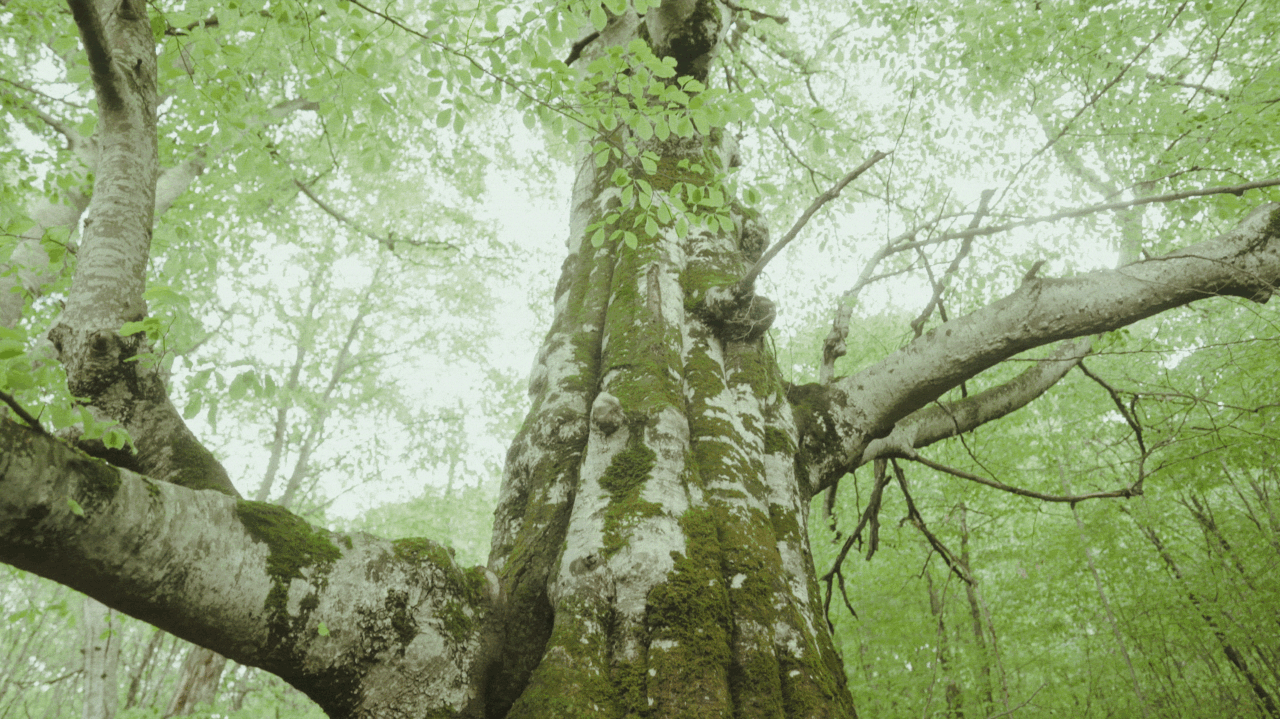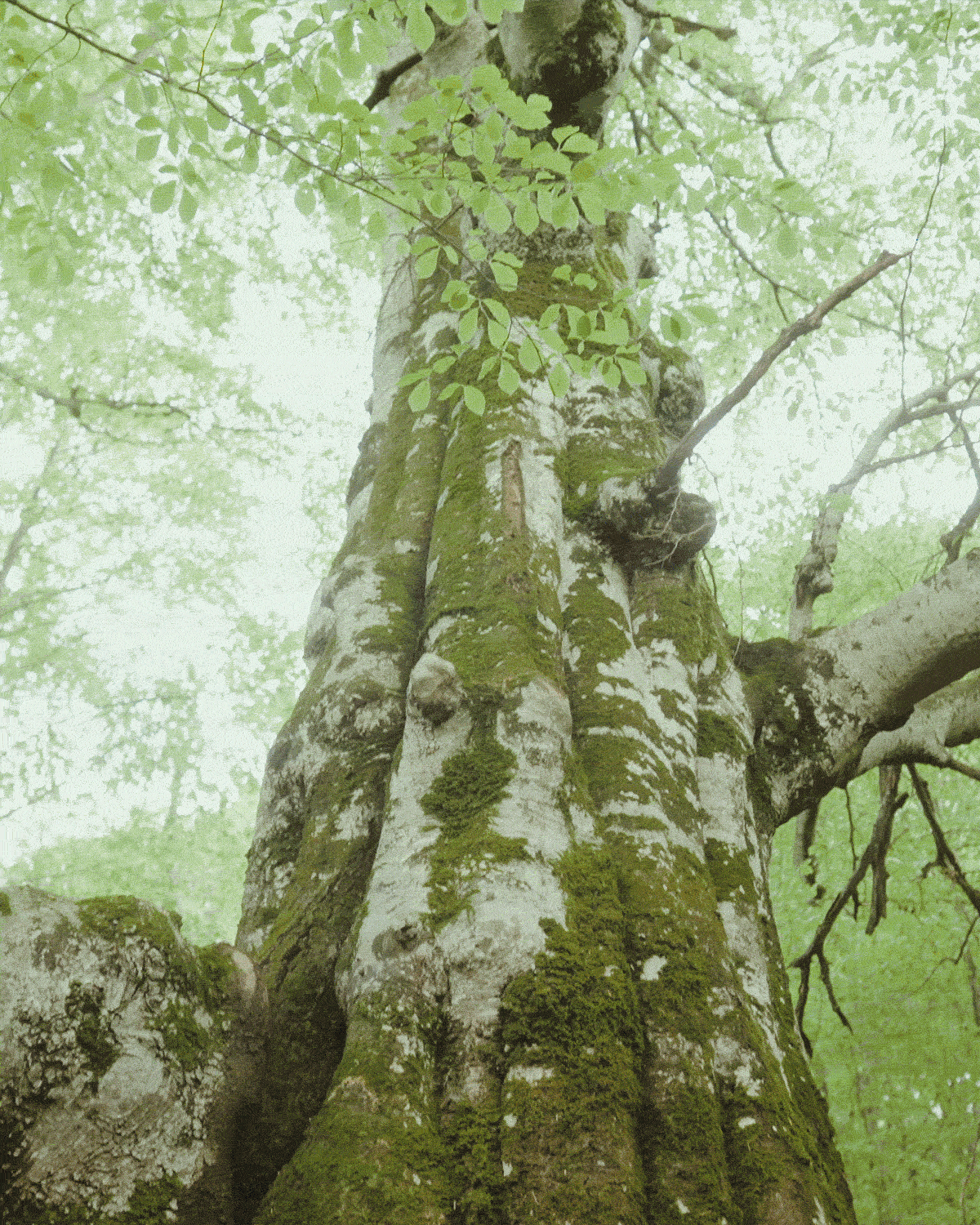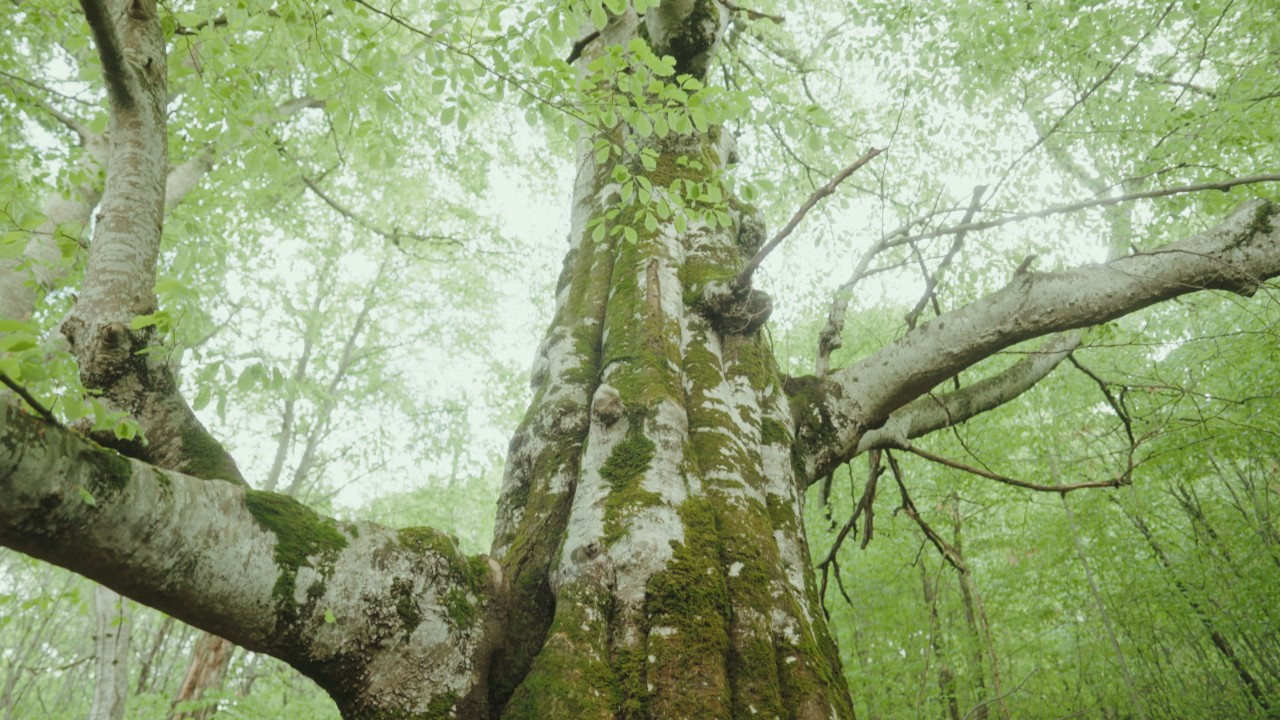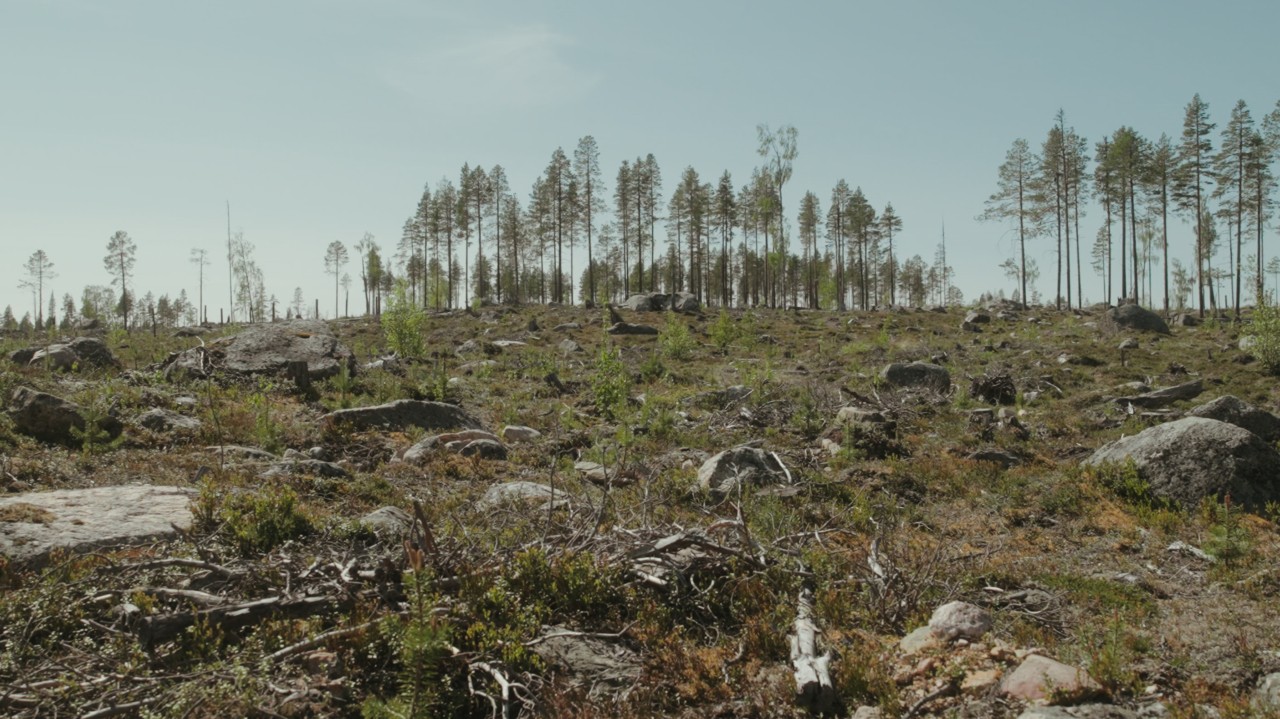

Film stills by Winslow Crane-Murdoch for Wild East documentary, Photo by Prajwal / Pexels
WORDS BY MAIA WIKLER
Snow blanketed the Eastern side of Romania’s Fagaras Mountains. It was quiet—except for the roar of chainsaws and trucks heaving with loaded logs. We stood breathless in a tight circle, having run through deep snow toward the cover of trees from an oncoming logging truck. “Look, look,” whispered Mihai, a Romanian forest investigator who is using a pseudonym for fear of reprisal. He pointed to the monitor of his drone as workers operating machinery pulled logs from destroyed riverbanks onto awaiting trucks.
For several minutes, we secretly watched the illegal operation unfold. Then, a ring on the walkie-talkie from a team member who was keeping watch by our parked car down the road. Get out, he warned. Another logging truck was coming, and we could miss our window to leave the forest without blowing our cover.
There was only one way in and out: a narrow road marked with nearly impassable, deep, frozen ruts. The forest is technically protected; it is part of Natura 2000, the world’s largest coordinated system of protected, highly valuable, threatened ecological areas, and the cornerstone of the European Union’s biodiversity policy. However, many Natura 2000 sites in Romania are being illegally logged. An insatiable hunger for timber has fueled an unprecedented pillaging of some of Europe’s last ancient forests.
Agent Green, a Romanian environmental nongovernmental organization, has spent the last 10 years exposing state corruption and the illegal, destructive practices of the timber industry. My small documentary film crew joined three Agent Green team members that day. In the depths of winter on a weekend afternoon, the risk of encountering loggers was low, the Agent Green team said. Within minutes, however, one confronted us as chainsaws buzzed in the distance.

Communism, in a way, functioned as a conservation time capsule in Romania. It preserved a significant amount of the country’s forests while rampant capitalism deforested most of Europe. Privatized global business interests were outlawed under communist rule; the forests and mountains belonged to the people. As a result, the Carpathian Mountains are now a refuge for some of Europe’s last ancient forests, brown bears, lynx, wolves, and bison.
At the height of communist dictator Nicolae Ceaușescu’s brutal reign, Romanians found refuge and solace in nature. Romanian activist Gabriel Paun, founder of Agent Green, grew up in Romania under communism. “Those years were very harsh,” he said. “You had to obey, or you had to pay a very high price for yourself and your family.”
After communism fell in 1989 and Romania joined the EU in 2007, the country’s forests opened for business, and massive land grabs occurred. Initially, Harvard University’s endowment fund exploited the opportunity and became the largest private landowner in Romania—until it realized how contentious the land acquisition deal was. The university quickly washed its hands clean by passing its purchase off to IKEA. Now, the fast furniture company, the world’s largest furniture retailer, is the largest private forest owner in Romania. The company consumes a tree every two seconds, and in nearly two decades, nearly two-thirds of Romania’s old-growth forests have been logged.
“I just remember the places where I used to grow up in the Carpathians, where there were intact forest landscapes,” said Paun. “Suddenly, after 2000, the companies came and started to cut… [Now] I can’t recognize the places. I immediately get disorientated.”
“IKEA is using the globally famous Swedish sustainable forestry model across the globe, which is based on doing a systematic expansion into the last remaining ecosystems, wiping away these ecosystems, pushing away and silencing indigenous peoples.”
The stakes are high for anyone who attempts to document, report, or organize against rampant deforestation in Romania. The nation’s timber industry operators, widely referred to as the “timber mafia,” have been speculated to be responsible for the deaths of at least six patrolmen from Romania’s Forest Guard in recent years; in another 650 registered incidents, people have been beaten, shot at, or otherwise attacked. Former Romanian Minister of Water and Forests, Doina Pana, survived mercury poisoning, which she believes was retaliation for her efforts to stop the timber mafia. Paun has also been targeted for his efforts in tracking and exposing the destruction of Romania’s forests. After surviving several assassination attempts and receiving a tip that the timber mafia has a bounty on him, he fled the country and now lives in hiding.
Arguably, IKEA benefits from the volatility in Romania. “In a context of systemic corruption, poor law enforcement and logging pressure from global timber markets, Romania’s forests are under massive threat of degradation and destruction,” a 2024 investigative report by Agent Green and Swiss ENGO, Bruno Manser Fonds, states. Their report, based on a year-long investigation into IKEA-owned forests and contractors, concluded that IKEA sources timber using destructive forestry practices, including in protected Natura 2000 sites. Forests rich in biodiversity were “fragmented, degraded, or even converted into barren landscapes,” the report states. These once-protected forests are now destined to become flat-pack furniture.
It’s emblematic of a broader issue in Europe: Primary and old-growth forests have declined so much that they represent less than 3% of the EU’s forests today; that decline is driven primarily by intensive timber harvesting. Given the dire situation, the EU recently developed guidelines for “mapping, monitoring and strictly protecting all the EU’s remaining primary and old-growth forests.”
IKEA prides itself on being people and planet-positive. But convenience comes at a cost. IKEA’s affordable, mass-produced fast furniture requires a steady stream of inexpensive timber.
Investigations by Agent Green, Greenpeace, and others have alleged that IKEA’s logging practices in high conservation-value forests fail to uphold EU biodiversity initiatives. IKEA disputes those claims. The company told Atmos that it abides by national and EU regulations, upholds certification from the Forest Stewardship Council, comports with U.N. principles on Indigenous rights, and doesn’t operate in legally protected areas.
FSC is a responsible forestry certification created to protect primary forests from logging in the Global North and agriculture in the Global South. But there are structural problems and conflicts of interest within FSC—including being cofounded by IKEA.
In an email to Atmos, IKEA claimed that standing tree volume has increased by 1 million cubic meters under the company’s stewardship. However, “that’s not very meaningful unless you break it down by age class and species,” said Dr. Peter Wood, an international forest policy expert at the University of British Columbia who previously served on FSC-rulemaking committees. That could represent millions of new saplings planted in previously clear-cut areas as forests continue to decline. Without a pre-logging baseline to compare the current situation to, along with the exact percentage of primary forest that remains compared to what was there before logging, Wood said, major loopholes emerge.
IKEA claimed it does not deforest under the Food and Agriculture Organization’s definition. However, this definition includes clearcuts as forested area, Wood explained. Indeed, recent grassroots efforts have tried to pressure companies to commit instead to ensuring their operations are “ancient- and endangered-forest-friendly.”
“Primary mixed-species forests are 70% more effective carbon sinks and less vulnerable to wildfires, droughts, and infestations than monoculture plantations. Yet, IKEA’s voracious appetite for the world’s forests expands unabated.”
Nonetheless, IKEA continues to maintain a global image of sustainability. IKEA operates the IKEA Foundation, which funds activists through a fellowship program, partners with environmental influencers for sponsored promotions, and partially funds the Doc Society Climate Story Fund, which supports documentary films on climate justice.
The company also rests its laurels on Sweden’s heritage and environmental reputation. Yet, the Swedish government and forest industry have allegedly targeted environmentalists such as Lina Burnelius for exposing IKEA and Sweden’s destructive forestry practices. Burnelius recently teamed up with Agent Green to prevent Sweden’s forests from meeting the same fate as Romania’s.
“[IKEA is] using the globally famous Swedish sustainable forestry model across the globe, which is based on doing a systematic expansion into the last remaining ecosystems, wiping away these ecosystems, pushing away and silencing indigenous peoples,” she explained. “Sweden is not the leader in sustainable forestry. We are the leader in greenwashing unsustainable forestry. And the FSC label has been their alibi… It’s certified destruction.”
Burnelius and her colleagues at Protect the Forest (Skydda Skogen) say they asked IKEA many times to show their suppliers, but to no avail. Burnelius believes the lack of supply chain transparency is deliberate. To address this, Burnelius’ colleague, Jon Andersson, created the first comprehensive, open-access database that maps forests throughout Sweden. Their monitoring recently revealed that 45,000 hectares have been approved for logging in high conservation value forests and irreplaceable primary forests.
I traveled with Burnelius to northern Sweden, past an unrelenting sea of tree plantations and clear cuts, where we documented Swedish forestry practices and several FSC-certified sites on the ground. We drove 6 hours from Umea to Jokkmokk, just north of the Arctic Circle on Sápmi lands, to meet with her friend Jannie, a Sámi reindeer herder. Sámi people claim their forests, which are integral to reindeer herds, are being destroyed by clear-cut logging, and that timber is likely in the IKEA supply chain.
Near Jokkmokk, a few patches of intact forests remain. Tufts of pistachio-colored lichen blanket the forest floor, and gauzy, black lichen drape the tree branches—food for the reindeer, which have followed the migration routes of their ancestors for generations. For nearly 2,000 years, the lives of the Sámi and the reindeer have been intertwined. The reindeer have provided the Sámi with food, clothing, tools, and shelter, all vital in the harsh Arctic environment, while also balancing the Arctic ecosystem. Reindeer herding remains a vital economic, cultural, and ecological practice. But forest loss could threaten it all.
Sámi herders need to put the reindeer inside corrals with supplementary feed because the “[tree] plantations are suffocating the lichen,” said Jannie. The tightly packed monocultures that have replaced primary forests don’t let in enough light to sustain lichens. A 2016 study found that 71% of Swedish forests with abundant lichen growth had disappeared in the six decades prior. Last winter, Jannie traveled 12 hours by car to gather enough lichen for the reindeer.
Jannie’s elders told her that when industrial-scale deforestation began in Sweden, the Sámi had abundant lands and lichen, so they were happy to share with the forestry companies. But now, she said, “we have nothing left to give here. They are looking at our empty wallets and want the entire wallet as well.”
Jannie’s experience is no exception. Swedish investigative journalist Lisa Röstlund reported countless Sámi reindeer herders with the same story of forest loss in her book, Forestland. An Investigation. “Time and again, I observed big players [in the forestry industry] cutting down old forests that were not allowed in FSC regulations, but they kept their certifications anyway,” said Röstlund.
Röstlund’s research culminated in sixty long-form articles, a large collection of both public and secret documents, and interviews with 248 individuals, some of whom held senior positions in departments of state or were employed by the forestry industry. She discovered internal reports from the Swedish government and forestry industry deliberately misleading the public to believe increased clear-cutting was good for the environment. To Röstlund, this draws “many parallels to the oil industry because of the reports that they know exactly what they are doing.”
Röstlund’s investigations drew threats from Sweden’s forestry industry. “I have never experienced anything like what I did when I published my stories about the Swedish forestry. [They] started a smear campaign toward me as an individual journalist,” she said. “I’ve heard from colleagues who have stopped reporting on that issue because the [industry] is so powerful.”
Now, the Swedish furniture empire is crossing hemispheres. IKEA has acquired more than 23,000 hectares of land in New Zealand since 2021, despite Māori dissent. The company plans to plant pine tree plantations, claiming climate benefits at the expense of Indigenous communities and natural ecosystems, per an investigation by the nonprofit, Disclose.
Primary mixed-species forests are 70% more effective carbon sinks and less vulnerable to wildfires, droughts, and infestations than monoculture plantations. Yet, IKEA’s voracious appetite for the world’s forests expands unabated. Ancient forests are a vital last line of defense against an intensifying climate crisis and rapidly declining biodiversity. The stakes are higher than ever. The planet, frontline defenders say, has already lost too much to see history repeat itself.

Bounties, Mafias, and the Climate Cost of IKEA’s Fast Furniture

